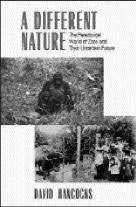A DIFFERENT NATURE: THE PARADOXICAL WORLD OF ZOOS AND THEIR UNCERTAIN FUTURE
by David Hancocks (University of California Press, $35)
A WISE MAN once observed that zoo people, or at least the more sentient ones, are like journalists, at least the more sentient ones. They’re highly passionate about what they do, and deeply ambivalent. They crave to believe their work is a higher calling, but they’re not sure it’s an honorable one.
That ambivalence suffuses this fascinating, often eloquent (though underedited), deeply informed, and ultimately frustrating book. A Different Nature is at once a history of zoos and the “zoological garden” idea, a manifesto for their transformation into temples of biodiversity and popular academies of conservation, a lament for all the ways they fall short, and a professional testament by the unlikely zoo director who did transform Seattle’s grim Woodland Park in the late 1970s and early ’80s, helping to ignite a (still unfinished) revolution in the way captive animals are kept and displayed.
Hancocks’ career reads like a fairy tale, though for him it hasn’t been an entirely happy one. A British-born architect with a deep sympathy for critters and the wild, he got his first zoo job as Woodland Park’s director. He spearheaded the creation of its breakthrough African Savannah and gorilla “exhibits”—a term that sounds meager and crass for settings so much more attentive to the animals’ needs and native habitats than anything zoos had attempted previously—and a master plan that his successors still follow today.
He left disenchanted with Seattle’s civic bureaucracy and lack of public commitment after voters failed to approve another zoo bond package (the voters themselves were disenchanted when they didn’t get the new elephant house they expected from the first bonds), and went on to lead Tucson’s celebrated Arizona-Sonora Desert Museum, the nearest model to the sort of synergistic institution he urges that zoos become. Rather than just animal displays, zoos should be one-stop immersions in the love and lore of nature that will induce visitors to not only gawk but (Hancocks soars) “want to live more lightly on the land, be more careful about using the world’s natural resources, and actually choose to vote for politicians who care about the wild inhabitants of the Earth and the wild places that remain.”
NEARLY EVERY ZOO manager would surely second Hancocks’ goals—when he or she takes time to consider them. But more and more, they’re occupied with the same grubby matters that occupy those who run any other sort of entertainment enterprise: publicity, sales, memberships, gates—not to mention bond issues. Unlike those who run symphonies or rock shows, they’re supposed to always be thinking about how to please the audience, educate the citizenry, and save the world’s endangered species. And neither the competition for people’s attention nor the pressures of extinction are going to abate any time soon. It’s not an easy job, and even Hancocks, with all his reflection and experience (he’s now director of one zoo in Australia and acting director of another), doesn’t offer a blueprint.
Hancocks doesn’t explain why, “of all the natural-history institutions that we have invented,” zoos rather than, say, museums or arboretums “have the greatest capacity to adapt, absorb new functions, and amalgamate the [others’] content.” And his prescription is either a tall order or an elephant mountain of clich鳮 But it gains freshness and authority if you know how he arrived at it. Unfortunately, you won’t learn that from his book.
Hancocks writes at length about the Desert Museum and Woodland Park’s African exhibits and the examples they set. But in an extraordinary display of quasi-journalistic reticence, he never mentions having had anything to do with them himself—not even on the dust jacket. On a recent Seattle visit, Hancocks said he wrote himself out of the story because he didn’t want to glom the credit due to Woodland Park staffers and the seminal “landscape immersion” architects Jones & Jones. But for all his modest intent, this gesture just comes off as evasive. The history Hancocks tells and the cause he espouses mean more if you know of his place in them.
So now you know. Take the book to the zoo, set yourself across the glass from the gorillas or orangs (who may peek over your shoulder), flip through its treasury of old photos, and recall that it wasn’t so long ago that we took concrete critter dungeons for granted. We’ve come a long way—but we have a longer way to go.









